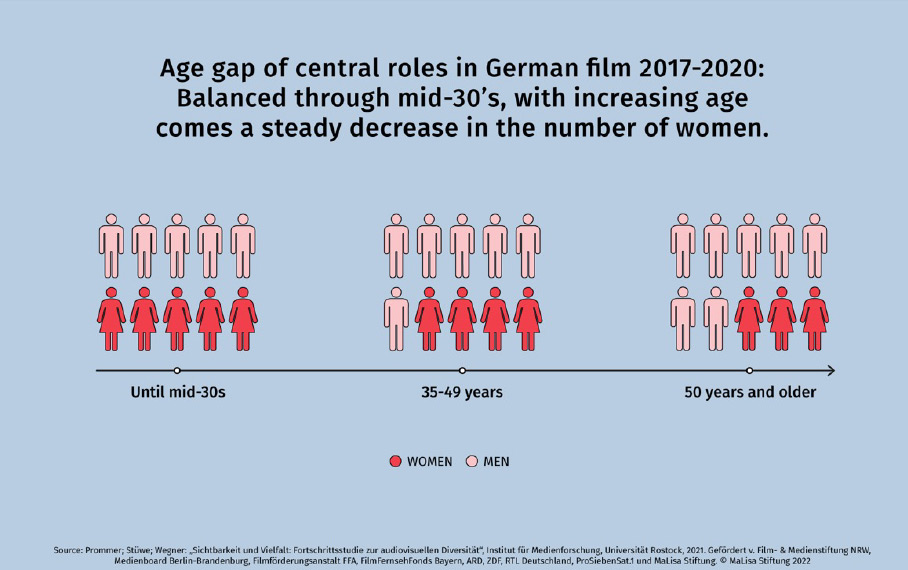WOMEN ON SCREEN – YOUNG, THIN, AND IN RELATIONSHIPS

A new analysis probed the question of whether women and men are equally represented in German cinema. The “Progress Study on Audiovisual Diversity,” led by Professor Elizabeth Prommer of the Institute for Media Research at the University of Rostock, shows that the proportion of women on screen has increased since 2017. However, women continue to be represented less diversely.
An initial survey from 2017 showed that the number of women and men seen on the big screen is unevenly distributed. The current analysis of gender representation in German cinema films from 2017 to 2020, which was launched with the MaLisa Foundation with its partner institutions, finds that while women are now depicted as protagonists almost as often as men, they continue to appear in less diverse roles.
In addition, the study showed that the number of female characters older than thirty continues to decline, and that more than two-thirds of the central characters over the age of fifty are male. While the total number of female and male protagonists decreases overall with increasing age in German cinema, this trend sets in for women as early as their mid-thirties, but for men as late as age fifty. The image of women seen in cinema is consistently severely limited: They are young, thin, and portrayed in the context of partnerships and relationships. Men, on the other hand, have recognizable professions, are occasionally overweight, and are portrayed in a more multidimensional way overall.
German cinema films now feature more women in leading roles, but do not depict the diversity of women in reality. Professor Elizabeth Prommer is particularly surprised by “how narrow the narrative corridor for female film characters still is. Men are portrayed with multiple facets; women are not.”
The analysis also shows that women continue to be underrepresented in creative roles behind the camera. For example, they directed a quarter of the feature films between 2017 and 2020 and were responsible for the screenplay in 24 percent of the 390 films studied. In cases where a woman directed or wrote the screenplay, there were significantly more women visible in the film.
“I am very pleased that clear progress can be seen when it comes to the visibility of women in motion pictures,” said Dr. Maria Furtwängler, co-initiator of the study. “However, we can by no means relax our efforts, because neither the age gap nor stereotypical gender representations have been overcome. We will continue to work with our partners to identify and implement the necessary solutions.”
KEY RESULTS
Nearly balanced gender ratio in central roles:
- In 2017-2020, nearly the same number of women (47%) as men (53%) had a central role. This represents an increase of 5%.
Representation of women is still limited:
- There is a persistent age gap: Women in the age group up to their mid-30’s appear equally often, then successively less often. The greatest imbalance is in the 50-plus age group. Here, 70% of the central film roles are played by men.
- Female protagonists, unlike male protagonists, are never overweight and almost three times as often (very) thin.
- The profession of male protagonists is more often recognizable than that of female protagonists, and they more often hold a high-level position.
- Women still appear more often in the context of partnerships and relationships.
Women are underrepresented in creative key positions:
- 25% of films were directed by women.
- A woman wrote the screenplay for 24% of the films, and a man for 58%. Mixed teams were responsible for 18% of the scripts, thus men were involved in 76% of the scripts.
- The gender of the creative team plays a role in the visibility of female protagonists. The more women are in positions of responsibility, the more women are seen in the film.
- If a woman directs, then the women characters’ stories are more extensive. In this case, 90% of the films pass the Bechdel-Wallace test. The Bechdel-Wallace test examines the extent to which women are reduced to partnerships and relationship with men.
The independent study was conducted by Professor Elizabeth Prommer of the Institute for Media Research at the University of Rostock. It was funded by the Film- und Medienstiftung NRW, the Medienboard Berlin-Brandenburg, the Filmförderungsanstalt FFA, the FilmFernsehFonds Bayern, the public broadcasters ARD and ZDF, the private broadcasters RTL Deutschland and ProSiebenSat.1, and the MaLisa Foundation.
A detailed summary of the results and graphics are available here. The complete results from the University of Rostock are available for download here. (In German)